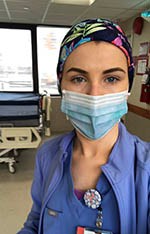Maura Quinn ’15 BSN, RN, OCN

Staff Nurse, Medical Intensive Care Unit
Montefiore Hospital, New York City
June 4, 2020
I remember the beginning as being a time of terrible uncertainty. I had obviously been watching the news and knew that this was going on in other parts of the world, but like many was naive in thinking that it would be like any other respiratory infection. I then read a study conducted on COVID ARDS Mortality published by ICU Nurses in Wuhan (China) and was instantly terrified. I started urging my family members and friends that this was certainly more serious than we first believed.
One morning I remember volunteering to take care of our first rule-out patient because I was the youngest nurse on the unit that day, thinking that I would want others to do the same if they were working on the unit with my mom (also a nurse!). However, the numbers soon started to rise exponentially and we started to hear that we would be floated to staff the other units as we oriented the nurses on those units on how to take care of vented patients, titrate drips, etc. The first morning that they sent ICU nurses to the med-surg floors, I went up with another ICU nurse and we began the process of equipping these units for critical care patients. The adaptability of my coworkers and the management of my unit was truly remarkable - our nurse leader traveled to every unit to make sure that we had what we needed to take care of these patients. He coordinated with pharmacy, bioengineering and IT to make sure that our workflow would be as close to normal as possible and that we could focus on taking care of patients safely while protecting ourselves from infection.
Another morning I was called to go down to the ER and help transport patients to the ICUs as they were vented and on drips and required a nurse escort, but the ER nurses were too overwhelmed. I was horrified by the sea of stretchers: every patient on a nonrebreather (mask), every patient gasping for air. It was an image I will never forget.
Soon, sedatives like propofol and fentanyl were on shortage. We were forced to consider alternatives. There was a small count of available ventilators. Every day seemed like an endless loop of overhead announcements calling “CAC” (code) or “Rapid Response” approximately every ten to twenty minutes. The mortality in the ICU was astounding, and we were trying everything we knew how to do. One Sunday, I waited hours for a single body bag because we had run out.
I don't remember the exact date, but one day I heard a “Happy Code” come across the loudspeaker and Alicia Keys’ “New York State of Mind” being played - a COVID patient had been discharged or successfully extubated and I honestly wept. It was a glimmer of hope in what seemed like a never-ending nightmare.
It would be tone-deaf to ignore the way that this pandemic disproportionately affected minority communities in New York City. The hospital I work in serves a very diverse patient population. Many of the patients we serve face severe socioeconomic challenges. Imagine a situation where we are relying on Facetime to have a family say goodbye to their loved one, but no one in that family owns an iPhone… It has challenged my perspective and magnified disparities that call for urgent changes to our healthcare delivery system.
My coworkers and I were stunned at the exceptional level of support coming from members of the Villanova community. Villanova alumna Frankki Romano organized food deliveries for our units and made sure that we felt supported. I was in contact with other Villanova nurses around New York to see how other healthcare networks were handling their IV tubing, CRRT machines, etc. to see if there was anything else we could try or contribute to help patient outcomes. A former colleague at Memorial Sloan Kettering, Mary Beth Frizzell (also a Villanova grad) put me in contact with a donor who wanted to contribute in some way to the efforts in NYC. Mary Beth selflessly passed him my information because she heard how hard the Bronx had been hit. The gentleman wanted to send meals or giftcards to the nurses, something to make us feel appreciated. I felt we were already getting meals and instead coordinated with him and the management on my unit to order several peripheral nerve stimulators and other products that would directly benefit COVID patients. So many of the patients were on paralytics during the surge and I noticed the absence of Train of Four utilization, so I felt this was the best way to make sure that his donation would serve not only the healthcare workers but the patients affected by COVID. This donor also purchased face protectors and eye dressings for patients which can be used to prevent facial pressure ulcers when patients are prone.
I will always appreciate the generosity of so many of the members of the Villanova community at this time and I am prouder than ever to be a Villanova Nurse.
